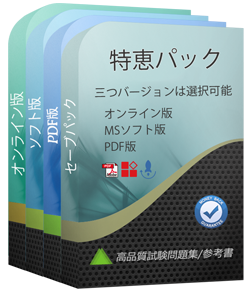あなたのテストエンジンはどのように実行しますか?
あなたのPCにダウンロードしてインストールすると、Microsoft 70-582テスト問題を練習し、'練習試験'と '仮想試験'2つの異なるオプションを使用してあなたの質問と回答を確認することができます。
仮想試験 - 時間制限付きに試験問題で自分自身をテストします。
練習試験 - 試験問題を1つ1つレビューし、正解をビューします。
Tech4Examはどんな試験参考書を提供していますか?
テストエンジン:70-582試験試験エンジンは、あなた自身のデバイスにダウンロードして運行できます。インタラクティブでシミュレートされた環境でテストを行います。
PDF(テストエンジンのコピー):内容はテストエンジンと同じで、印刷をサポートしています。
あなたは70-582試験参考書の更新をどのぐらいでリリースしていますか?
すべての試験参考書は常に更新されますが、固定日付には更新されません。弊社の専門チームは、試験のアップデートに十分の注意を払い、彼らは常にそれに応じて70-582試験内容をアップグレードします。
割引はありますか?
我々社は顧客にいくつかの割引を提供します。 特恵には制限はありません。 弊社のサイトで定期的にチェックしてクーポンを入手することができます。
更新された70-582試験参考書を得ることができ、取得方法?
はい、購入後に1年間の無料アップデートを享受できます。更新があれば、私たちのシステムは更新された70-582試験参考書をあなたのメールボックスに自動的に送ります。
返金するポリシーはありますか? 失敗した場合、どうすれば返金できますか?
はい。弊社はあなたが我々の練習問題を使用して試験に合格しないと全額返金を保証します。返金プロセスは非常に簡単です:購入日から60日以内に不合格成績書を弊社に送っていいです。弊社は成績書を確認した後で、返金を行います。お金は7日以内に支払い口座に戻ります。
購入後、どれくらい70-582試験参考書を入手できますか?
あなたは5-10分以内にMicrosoft 70-582試験参考書を付くメールを受信します。そして即時ダウンロードして勉強します。購入後に70-582試験参考書を入手しないなら、すぐにメールでお問い合わせください。
70-582テストエンジンはどのシステムに適用しますか?
オンラインテストエンジンは、WEBブラウザをベースとしたソフトウェアなので、Windows / Mac / Android / iOSなどをサポートできます。どんな電設備でも使用でき、自己ペースで練習できます。オンラインテストエンジンはオフラインの練習をサポートしていますが、前提条件は初めてインターネットで実行することです。
ソフトテストエンジンは、Java環境で運行するWindowsシステムに適用して、複数のコンピュータにインストールすることができます。
PDF版は、Adobe ReaderやFoxit Reader、Google Docsなどの読書ツールに読むことができます。
Microsoft Windows Embedded Standard 7 for Developers 認定 70-582 試験問題:
1. You are creating a Windows Embedded Standard 7 image for a target device. You plan to use a new hardware platform for the device. You need to import the devices hardware information into Image Configuration Editor (ICE). You also need to minimize the amount of information you are importing. What should you do?
A) Start the target device by using WindowsPE and execute the TAP.exe tool.
B) Start the target device by using WindowsPE and execute the lmageX.exe tool.
C) Start the target device with MS-DOS and execute the TAP.exe tool.
D) Start the target device with retail Windows and execute the lmageX.exe tool.
2. You have a resealed Windows Embedded Standard 7 image on a target device. The image will be deployed to multiple devices. You are provided two text files named Exclusionl_ist.txt and Exclusion.txt. The ExclusionI_ist.txt file contains the following text: [ExclusionList] *.XR5 The Exclusion.txt file contains the following text: [Exclusion] *.XR5 You need to ensure that the captured image meets the following requirements: It remains resealed.lt excludes files that contain the XR5 extension.lt can be used for successful deployment on multiple devices. What should you do?
A) Start
the
device by using the
installed
image.
Use
the ImageX
tool along
with the /CAPTURE and/CONFIG Exclusion.txt switches to capture a Windows Image (WIM) file.
B) Start the device by using WindowsPE. Use the ImageX tool along with the /CAPTURE and /CONFIG Exclusion.txt switches to capture a Windows Image (WIM) file.
C) Start the device by using
the
installed
image. Use the ImageX
tool along with the /CAPTURE and/CONFIG Exclusionl_ist.txt switches to capture a Windows Image (WIM) file.
D) Start the device by using WindowsPE. Use the ImageX tool along with the /CAPTURE and /CONFIG Exclusionl_ist.txt switches to capture a WindowsImage (WIM) file.
3. You are deploying a Windows Embedded Standard 7 image to a portable device. You build and test the device by using only English as the language. End users must be able to select a language other than English from the Windows Welcome screen. You need to ensure that the device includes both languages. You need to achieve this goal without taking the device offline. What should you do?
A) Use an unattended answer file with a RunSynchronous command in the oobeSystem pass to invoke the Ipksetup /i <locale> /p<path to LPxab> command.
B) Install the language pack for the selected language by using the DISM /online /Add- Package/PackagePath:LPxab
command.
Run
the Sysprep /oobe /shutdown
command. Lang.ini file to include the
C) Use an unattended answer file that includes the language pack for the selected language. Run the DISM /online/Apply_Unattend:<"unattend.xml"> command.
4. You are creating a Windows Embedded Standard 7 image for a target device. You have a third-party device driver that is critical during system startup. You have an INF file and binary files for the device driver. You need to add the device driver to the image. What should you do in Image Configuration Editor (ICE)?
A) Insert a synchronous command during the Specialize pass.
B) Insert a synchronous command during the auditUser pass.
C) Configure the DriverPaths setting to install the device driver during the auditSystem pass.
D) From the distribution share, add the device driver from the Out-of-Box Drivers folder. Configure the settings to install the driver during the WindowsPE pass.
5. You are developing a Windows Embedded Standard 7 image. You need to implement a recovery method on the hard disk that contains the image. What should you do?
A) Use the Diskpart tool to create a second partition. Use the lmageX.exe tool to apply the WindowsPE Boot.wim file to the partition. Copy the Bootmgr file and the \boot directory to the root of the partition. Create a new boot configuration database to enable booting from the partition.
B) Start the device that contains the image by using WindowsPE. Use the lmageX.exe tool to append the WindowsPE Boot.wim file to the target image file. Add the system recovery image to the partition.
C) Use the Diskpart tool to create a second partition on the hard disk. On the device that contains the image, access the Control Panel/System and Security feature and select the Backup and Restore option. Select the Create a System Image option and place the image on the second partition.
D) Use the Diskpart tool to create a recovery partition on the hard disk that contains the image. Copy the WindowsPE source files to the hard disk drive. Use the Diskpart tool to mark the partition as Read-Only.
質問と回答:
| 質問 # 1 正解: A | 質問 # 2 正解: D | 質問 # 3 正解: B | 質問 # 4 正解: D | 質問 # 5 正解: A |


 弊社は製品に自信を持っており、面倒な製品を提供していません。
弊社は製品に自信を持っており、面倒な製品を提供していません。



 -Konno
-Konno

